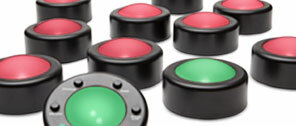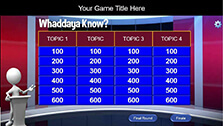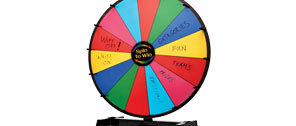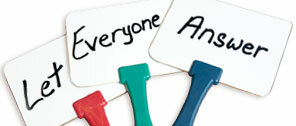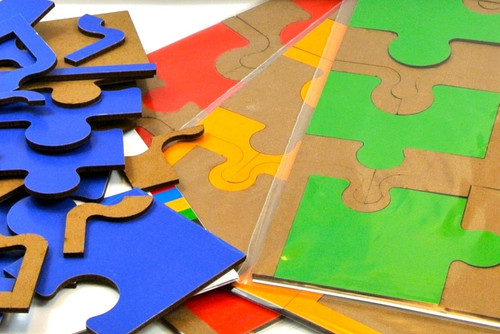COLOURBLIND® was developed in 1991 for training Air Traffic Controllers in Great Britain -- where team communication is fundamental to success and where absolutely no margin for error, misunderstanding or ambiguity can be tolerated. Since then, COLOURBLIND has been used worldwide across languages, cultures and business backgrounds, to focus on the fundamental skills of great two-way communication and the achievement of shared meaning. It is also used to explore team problem-solving, team understanding of abstract concepts and to explore team culture. Colourblind is now listed as a 'Preferred Learning Material' by ILM (Institute for Leadership and Management), Europe's foremost leadership and management training provider.
Wearing blindfolds to ensure total dependence upon the quality of their verbal communication, and holding a collection of small, irregular, coloured plastic shapes, a group works together to gather information that will allow them to solve a puzzle. The size of the group (between 4 and 28) demands different types of skill: information and group management, effective listening and questioning, strong chairing skills, the ability to clarify and summarize and the need for feedback to ensure understanding.
Colourblind Plus is a new activity based on the success and inherent challenges within the original Colourblind -- a classic verbal problem-solving activity that has been used for over 20 years to help teams reach a common understanding of meaning, and recognize problems caused with imprecise communication patterns. Colourblind Plus extends the original activity through the introduction of 6 new shapes, so that those already familiar with Colourblind will find this activity to be a similar but more difficult challenge.
3 GREAT ACTIVITIES
Colourblind Plus contains 3 separate activities:
- A paired communications activity - each participant is paired back to back with another and must use verbal description only to determine which of the three shapes they have is the odd one out. This is a deceptively challenging activity due to the careful design of of the new abstract Colourblind Plus shapes!
- The second activity can build on the first by bringing 2 pairs together, and using blindfolds to again determine which is the odd shape in the group -- the addition of extra pieces and the blindfolds in this activity challenges the group to determine whether they have new or similar shapes to those they may have previously seen.
- Finally the third activity mirrors the challenge in the original Colourblind -- this time the new abstract shapes will present a much greater challenge than the original, and will require a far greater detail of accurate description to reach the successful answer to the challenge: 'What is the colour and shape of the two missing pieces?' Individuals draw on their experience and descriptive skills to explain to each other the complexities of abstract shapes that they can hold in their hands, but not see (participants are blindfolded). They use feedback and the skills of clarification to ensure that their understanding is accurate.
SUCCESS REQUIRES COMMUNICATION EXCELLENCE
- Set up and manage an effective communication system that everyone understands and can use efficiently.
- Develop a dialogue which will lead to a common understanding of abstract concepts.
- Deliver a successful solution to the problem they face.
LEARNING OBJECTIVES
- To understand that effective communication is a two-way process requiring a message to be sent and the meaning to be received in the way the sender intended
- To consider how to improve both communication systems and the quality of the messages which those systems support
- To practice effective listening and refine questioning skills
- To develop flexibility in communication, changing and adapting language to meet the needs of the listeners
- To understand how our communication is culturally specific and how to ensure that we are using shared references to achieve common meaning.
ACTIVITY DESCRIPTION
Outlined below are the descriptions of the three separate (but related) activities contained within Colourblind Plus
1. Paired Version
Up to 4 pairs (with an optional observer per participant) are seated back to back so that they cannot see what each other is holding. Each participant is handed some shapes, and the objective is to decide which of the them is the odd one out. The pair has 10 minutes to provide a single final answer, and there is an optional set of observer notes that can be used to include an observer to provide individual feedback.
2. Small Group Version
Four participants (plus observers if required), are brought together, seated and blindfolded for this (second stage) activity. As in the previous activity they will again be tasked with identifying the shapes which do not exactly match from the distributed set. If this activity follows the initial paired activity they may recognise the feel of some shapes as they will have seen and handled them before, but some may be new to them. The participants cannot transfer or exchange their pieces with each other and are reliant only upon high quality verbal communication to solve their problem. At the end of the exercise they must identify a single group answer to the problem. Each group has up to 20 minutes to provide a single, final answer to the problem.
3. Large Group version
Each participant (ideally between 6 and 16) is seated, blindfolded and issued with a number of small plastic pieces. The brief suggests that the group has to identify the colour and shape of two pieces that were removed from the complete set of plastic pieces before they were distributed amongst the participants. The participants cannot transfer or exchange their pieces with each other and are reliant only upon high quality verbal communication to solve their problem. At the end of the exercise they must identify a single group answer to the problem.
TIME EXPECTATIONS: A period of between 20 - 45 minutes intense verbal information exchange and problem-solving approaches will typically be required depending on the abilities within the group. Should the group already have progressed through the paired and small group versions described above, then this activity will be much easier than if they begin with this Large Group version, as this is a challenging activity.
VIEW VIDEO DEMO
TIME DURATION
Duration: 20-60 minutes plus review, using 1, 2, or 3 activities in pack
Group Size: Ideal 6-16. Possible 4-28
INCLUDES
- 20 blindfolds
- 6 puzzle pieces in each of 5 colors (30 pieces total)
- Binder with Facilitation notes
Colourblind is designed by RSVP Design Ltd, now validated by ILM.


